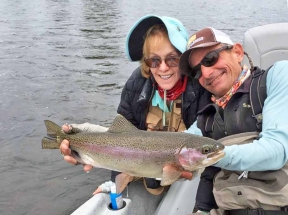
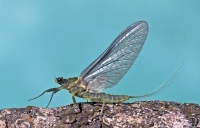
Mention the word “Flav” in circles outside of Fork Town and you might get some weird looks, even within fly fishing circles. Most mayflies have cool names like Green Drake, Pale Morning Dun, etc. but Flav? The common name is derived from the scientific classification, Drunella flavilinea. Early writers like Fred Arbona tried to give it a little more refined title of Small Western Drake but the title never really stuck. Today it is what it is – it’s a Flav.
The Flav is a fairly large mayfly best matched with a size 14 hook. It looks very much like its larger cousin, the Western Green Drake (Drunella grandis.) They are very similar in appearance to their larger cousins with three tails, a bright olive body, and dark dusky slate wings. It doesn’t take a lot of them on the water to get the trout’s attention. One reason is, like the Green Drake, Flavs put up quite a struggle when they emerge. Emerging at the surface, they can’t be content with just drifting in the film and letting it happen. Instead they wiggle and struggle to free themselves from their nymphal shucks, and start fluttering their wings in an effort to escape. Flavs might be the most impatient of all mayflies. Not only does all of this commotion draw attention from the trout, but their large hefty bodies offer a meaty morsel.
Flav spinners are also very important. You’ll see them on the water on calm clear mornings. I’ve also seen them at dusk but my favorite fishing is to get out early and hike down in the Ranch to find their spinners on the water. You can easily match them with a size 14 Rusty Spinner. You’ll usually find them mixed with smaller PMD Spinners. However, if you see a few of them on the water you can bet the trout will be scarfing them up. One of my favorite patterns is a Hi-Vis Rusty Spinner. I usually clip the orange indicator down and I like to thin down the wings.
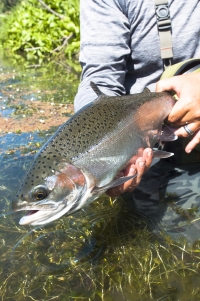
Flavs normally start showing up on the Henry’s Fork toward the tail end of the Green Drake hatch in late June or early July. Year in and year out it has coincided nicely with the Wimbledon Tennis Tournament. The best hatches usually occur during the afternoon hours. The timing of the daily emergence is sensitive to air and water temperature. Cool overcast weather produces low density hatches that usually continue throughout the afternoon hours into the evening. During this kind of weather the hatches seem to intensify in waves that occur every half hour or so. Conversely warm dry weather can bring high density hatches that occur for only a short time in the late afternoon or early evening hours.
Such was the case a few years ago when I floated the wade section of the Madison River with Mick Mickelson and my son Chris. We launched from the Reynolds Pass Bridge early in the afternoon. We stopped here and there catching a few fish, blind fishing the pockets and riffles. Later on we parked near a long soft pool where we saw a few trout rising. It wasn’t long until the rises intensified. A quick look at the water confirmed why the rises had changed from soft sips to slashes and violent boils. The surface was covered with Flavs!
We lost track of time. The last thing I had on my mind was the hour and a half left to float down to the takeout at Piney Bluff. By the time we came to our senses it was dark. I left plenty of gel coat after hitting at least half of the rocks on the Madison until we reached the bottom of the float. We were cold and miserable, happy to be back at the truck. We often talk about that day but we don’t talk much about how cold we were. Nothing else matters. We only talk of the great hatch of Flavs.
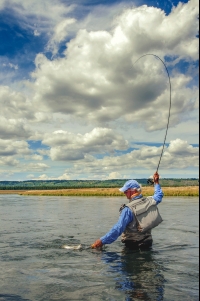
I’ve never understood why Flavs only occur on a few select rivers of the Yellowstone Region. I’ve hit some great Flav hatches on the Yellowstone River in the Park. In fact, I plan to fish the Yellowstone when it opens on July 15th and I’ll make sure to have plenty of Flavs. Along with the Madison in Montana they are definitely one of the super hatches of the Henry’s Fork. They start up on the lower river below Ashton in mid-June and finish out at Last Chance about a month later. I have never found them on the South Fork of the Snake, Fall River, the Teton River and other tributaries of the Henry’s Fork.
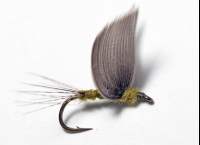
From my experience the best patterns to imitate the Flav are emergers and cripples. I’m sure this is due to the fact that they are so impatient, reckless and wacko during the emergence process. As previously noted, they are not content to simply ride the surface until their wings dry so they can fly off. Rather they are usually trying to fly before they even get settled on the surface. Rene’ Harrop has developed three patterns that work great to imitate emerging Flavs. You’ll be perfectly set if you have some Captive Duns, Biot Emergers and Last Chance Cripples in your box. Quigley’s Sparkle Flag and Flav Thorax are great patterns to imitate the dun. If restricted to only one pattern it would be, without question, the Flav Nohackle. The duck quill wings look almost too pretty to fish when the fly is fresh. It’s not until the wings get smushed up that this great fly comes into its own. It can look like a fresh emerger stuck in the surface film, a cripple that will never make the cut, or it can look like a dun drifting on the surface trying to figure out what to do next.
It might take a few trips to the river to get it right but when you do, you’ll never forget it.